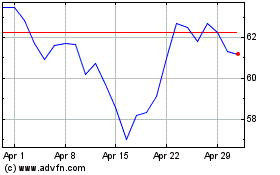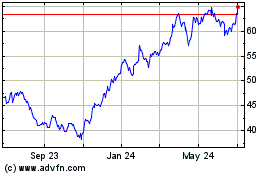Palm-Oil Prices Hit 21-Month High, but Pessimism Grows
February 05 2016 - 6:10AM
Dow Jones News
Palm-oil prices surged to a fresh 21-month high Friday, though
market watchers are becoming more pessimistic over the outlook for
one of the few bright spots among global commodities in recent
months.
The benchmark crude palm-oil future contract traded on the Bursa
Malaysia Derivatives exchange has reached its highest level since
May 2014 at 2,585 ringgit (US$630), having rallied almost 38% since
August last year amid concerns about supply.
Those worries are now starting to recede, in part because the
peak of the El Niñ o weather phenomenon that has brought dry
weather to the region in recent months, affecting palm-crop yields,
has now passed.
In addition, analysts say Indonesia—which along with Malaysia
produces around 85% of the world's palm—may have to pull back on
plans to raise the amount of the commodity it mandates should be
used in biodiesel production. Any scaling back will place less
pressure on palm- supplies.
"I don't think it [the palm-oil price] will go much beyond this
because I think the biodiesel story is too overhyped" and the
supply of oilseed, which includes palm oil and soybean, remains
ample, said Aurelia Britsch, an analyst at BMI Research. She
expects prices will top out at around 2,600 or 2,700 ringgit a ton
in the next three months.
Palm oil's price increase in recent months has been driven in
part by worries that dry weather and haze across south east Asia
caused by three months of fires in Indonesia would hurt output of
the oil, which is used in products as varied as lipstick and
cookies.
The impact of last year's dry conditions is starting to reduce
yields. Total crude palm-oil production was down 15.4% in December
from the previous month, according to the Malaysia Palm Oil Board.
But with palm-oil stocks still plentiful, some feel that worries
about supply have become overblown.
Total palm-oil stocks in Malaysia in December 2015 were 31%
higher than the prior year, according to data from the Malaysia
Palm Oil Board. Indonesia doesn't release similar data.
"We are still going to face an oversupply situation with weaker
demand going forward," said David Ng, an analyst at Phillip Futures
in Kuala Lumpur.
Analysts are also skeptical over whether Indonesia will adjust
its so-called biodiesel mandate, forcing producers to blend up to
20% of a palm-oil feedstock into fuels from the current 15%
requirement.
Indonesia subsidizes biodiesel, which is more expensive than
gasoline, through a tax raised on palm-oil exports. But with
crude-oil prices still languishing at low levels, the cost of that
subsidy is getting higher. Adding more of the relatively expensive
palm oil to the biodiesel mix would only make the potential cost
even higher.
"Indonesia, in particular will face a larger financial challenge
to fulfill its ambitious mandate—as a result, lower than expected
demand of palm oil could cap any potential price gains," analysts
at Rabobank said in a note.
Malaysia had planned to begin increasing the palm-oil content in
biodiesel to 10% of the fuel from 7% in October 2015 but this has
still not been implemented, and as yet no time frame has been
outlined for the increase.
Another headwind facing palm oil is falling prices of soy oil, a
substitute product.
Soybean oil traded at $104 higher per ton on average than palm
oil in 2015. But that premium has narrowed this year to about $90,
according to analysts at Commerzbank, who said soybean prices have
dipped because good weather in South America has resulted in a
bumper crop. Such trends are likely to increase soy-oil consumption
ahead of palm oil, Commerzbank said.
Already, Malaysia's palm-oil exports fell 9.9% in January from
February, according to data released by cargo surveyor Intertek
Agri Services.
Write to Lucy Craymer at Lucy.Craymer@wsj.com
(END) Dow Jones Newswires
February 05, 2016 05:55 ET (10:55 GMT)
Copyright (c) 2016 Dow Jones & Company, Inc.
Citigroup (NYSE:C)
Historical Stock Chart
From Mar 2024 to Apr 2024

Citigroup (NYSE:C)
Historical Stock Chart
From Apr 2023 to Apr 2024
